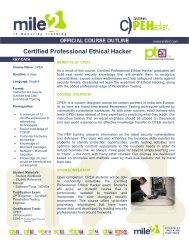Certified Penetration Testing Engineer - Mile2
Certified Penetration Testing Engineer - Mile2
Certified Penetration Testing Engineer - Mile2
You also want an ePaper? Increase the reach of your titles
YUMPU automatically turns print PDFs into web optimized ePapers that Google loves.
20.1 Overview<br />
20.2 Introduction<br />
20.3 Encryption<br />
20.4 Cryptographic Definitions<br />
20.5 The Science of Secret Communications<br />
20.6 Encryption Algorithm<br />
20.7 Implementation<br />
20.8 Symmetric Encryption<br />
20.9 Symmetric Downfalls<br />
20.10 Symmetric Algorithms<br />
20.11 Crack Times<br />
20.12 Asymmetric Encryption<br />
20.13 Asymmetric Advantages<br />
20.14 Asymmetric Disadvantages<br />
20.15 Asymmetric Algorithms<br />
20.16 Key Exchange<br />
20.17 Symmetric vs Asymmetric<br />
20.18 Hybrid Encryption<br />
20.19 Hashing<br />
20.20 Common Hash Algorithms<br />
20.21 Birthday Attack<br />
20.22 Hash Demo<br />
20.23 Security Issues in Hashing<br />
20.24 Hash Collisions<br />
20.25 MD5 Collision Creates Rogue Certificate<br />
Authority<br />
20.26 More Hybrid Encryption<br />
20.27 Digital Signatures<br />
20.28 SSL/TLS<br />
20.29 SSL Connection Setup<br />
20.30 SSL Hybrid Encryption<br />
20.31 SSH<br />
20.32 IPSec<br />
20.33 PKI<br />
20.34 Quantum Cryptography<br />
20.35 Attack Vectors<br />
20.36 Network Attacks<br />
20.37 More Attacks<br />
20.38 Review<br />
20.39 A5 Lab – Cryptography<br />
20.39.1 Exercise 1 – Caesar Encryption<br />
20.39.2 Exercise 2 – RC4 Encryption<br />
20.39.3 Exercise 3 – IPSec Deployment<br />
Appendix 6 – Economics and Law<br />
21.1 Overview<br />
21.2 Security Incentives and Motives<br />
21.3 What is Your Weakest Link?<br />
21.4 What is the Value of an Asset?<br />
21.5 Non-Obvious Vulnerabilities<br />
21.6 Categorizing Risks<br />
21.7 Types of Losses<br />
21.8 Approaches to Analyzing Risk<br />
21.9 Who Uses What Analysis Type?<br />
21.10 Qualitative Analysis Method<br />
21.11 Quantitative Analysis<br />
21.12 Can a Purely Quantitative Method be<br />
accomplished?<br />
21.13 Comparing Cost and Benefit<br />
21.14 Cost of a Countermeasure<br />
21.15 CyberCrime<br />
21.16 Not Just Fun and Games<br />
21.17 Example of Computer Crimes<br />
21.18 Perpetrators<br />
21.19 Attack Types<br />
21.20 Telephone Fraud<br />
21.21 Identification Protection and Prosecution<br />
21.22 Privacy of Sensitive Data<br />
21.23 Privacy Issues – US Laws and Examples<br />
21.24 EU Principles on Privacy<br />
21.25 Transborder Information Flow<br />
21.26 Employee Privacy Issues<br />
21.27 U.S. Law<br />
21.28 Common Laws – Civil<br />
21.29 Common Laws – Criminal<br />
21.30 Common Laws – Administrative<br />
21.31 U.S. Federal Laws<br />
21.32 Intellectual Property Laws<br />
21.33 Trademark and Patent<br />
21.34 Software Licensing<br />
21.35 Digital Millennium Copyright Act<br />
21.36 Investigating<br />
21.37 Computer Crime and its Barriers<br />
21.38 Countries Working Together<br />
21.39 Security Principles for International Use<br />
21.40 Has a Crime Been Committed?<br />
21.41 Bringing in Law Enforcement<br />
21.42 Citizen vs Law Enforcement Investigation<br />
21.43 Investigation of Any Crime<br />
21.44 Role of Evidence in a Trial<br />
21.45 Evidence Requirements<br />
21.46 Chain of Custody<br />
21.47 How Evidence is Processed<br />
21.48 Evidence Types<br />
21.49 Hearsay Rule Exception<br />
21.50 Responding to an Incident<br />
21.51 Preparing for a Crime before it happens!<br />
21.52 Incident Handling<br />
21.53 Evidence Collection Topics<br />
21.54 Specialized Skill<br />
21.55 Trying to Trap the Bad Guy<br />
21.56 Companies Can be Found Liable!<br />
21.57 Review<br />
10



